fuel consumption FIAT DUCATO 2012 Owner handbook (in English)
[x] Cancel search | Manufacturer: FIAT, Model Year: 2012, Model line: DUCATO, Model: FIAT DUCATO 2012Pages: 287, PDF Size: 4.5 MB
Page 29 of 287
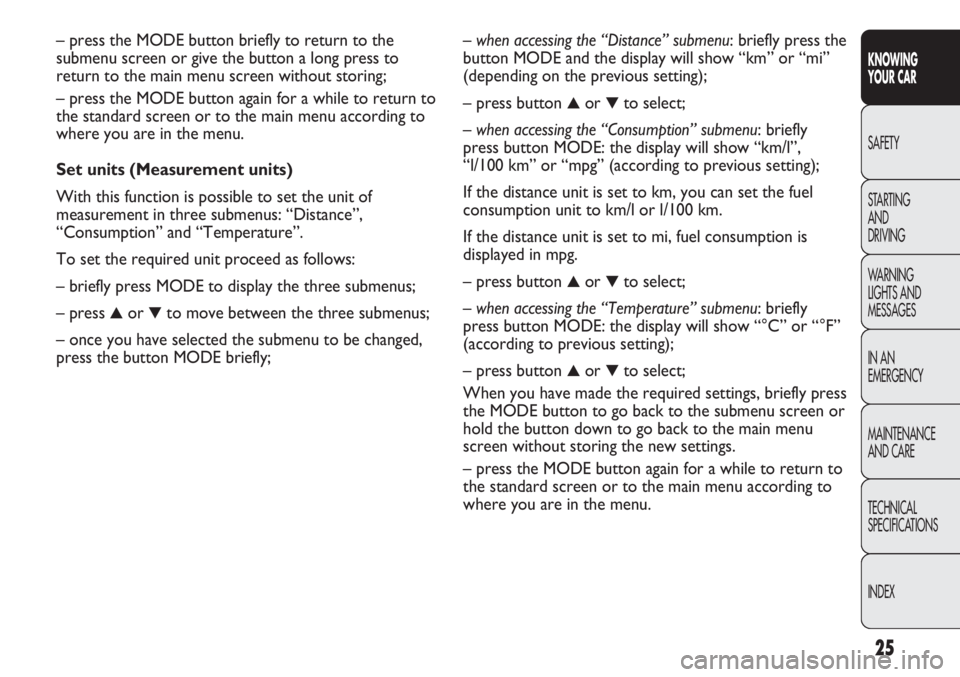
25
KNOWING
YOUR CAR
SAFETY
STARTING
AND
DRIVING
WARNING
LIGHTS AND
MESSAGES
IN AN
EMERGENCY
MAINTENANCE
AND CARE
TECHNICAL
SPECIFICATIONS
INDEX
– when accessing the “Distance” submenu: briefly press the
button MODE and the display will show “km” or “mi”
(depending on the previous setting);
– press button
▲or ▼to select;
– when accessing the “Consumption” submenu: briefly
press button MODE: the display will show “km/l”,
“l/100 km” or “mpg” (according to previous setting);
If the distance unit is set to km, you can set the fuel
consumption unit to km/l or l/100 km.
If the distance unit is set to mi, fuel consumption is
displayed in mpg.
– press button
▲or ▼to select;
– when accessing the “Temperature” submenu: briefly
press button MODE: the display will show “°C” or “°F”
(according to previous setting);
– press button
▲or ▼to select;
When you have made the required settings, briefly press
the MODE button to go back to the submenu screen or
hold the button down to go back to the main menu
screen without storing the new settings.
– press the MODE button again for a while to return to
the standard screen or to the main menu according to
where you are in the menu. – press the MODE button briefly to return to the
submenu screen or give the button a long press to
return to the main menu screen without storing;
– press the MODE button again for a while to return to
the standard screen or to the main menu according to
where you are in the menu.
Set units (Measurement units)
With this function is possible to set the unit of
measurement in three submenus: “Distance”,
“Consumption” and “Temperature”.
To set the required unit proceed as follows:
– briefly press MODE to display the three submenus;
– press
▲or ▼to move between the three submenus;
– once you have selected the submenu to be changed,
press the button MODE briefly;
Page 33 of 287

29
KNOWING
YOUR CAR
SAFETY
STARTING
AND
DRIVING
WARNING
LIGHTS AND
MESSAGES
IN AN
EMERGENCY
MAINTENANCE
AND CARE
TECHNICAL
SPECIFICATIONS
INDEX
Values displayed
External temperature
Indicates the temperature outside the vehicle passenger
compartment.
Range (for versions/markets where provided)
It indicates the distance that can still be travelled based
on the fuel in the tank assuming that driving conditions
will not change. The message “---” will appear on the
display in the following cases:
– range value lower than 50 km (or 30 mi)
– vehicle left parked with engine running for long
period.
Trip distance
This value shows the distance covered from the start of
the new mission.
Average consumption (for versions/markets where provided)
This value shows the average consumption from the
start of the new mission.
Instant consumption (for versions/markets where provided)
This indicates instant fuel consumption and it is
constantly updated. The message “---” will appear on
the display if the vehicle is parked with the engine
running.
Average speed
Represents the average vehicle speed as a function of
the overall time elapsed since the start of a new mission.TRIP COMPUTER
General information
The “Trip computer” is used to display information on
vehicle operation when the key is turned to
MAR-ON.
This function allows you to define two separate trips,
called “Trip A” and “Trip B”, for monitoring the
vehicle’s “complete mission” (journey) in a reciprocally
independent manner. Both functions can be reset (reset
means start of a new journey).
“Trip A” is used to display the figures relating to:
– Outside temperature
– Range
– Trip distance
– Average consumption
– Current consumption
– Average speed
– Trip time (driving time).
“Trip B”, available on multifunction display only, is used
to display the figures relating to:
– Trip distance B
– Average consumption B
– Average speed B
– Trip time B (driving time).
NOTE “Trip B” function can be excluded (see paragraph
“Trip B on”). “Range” and “Instant consumption”
parameters cannot be reset.
Page 152 of 287
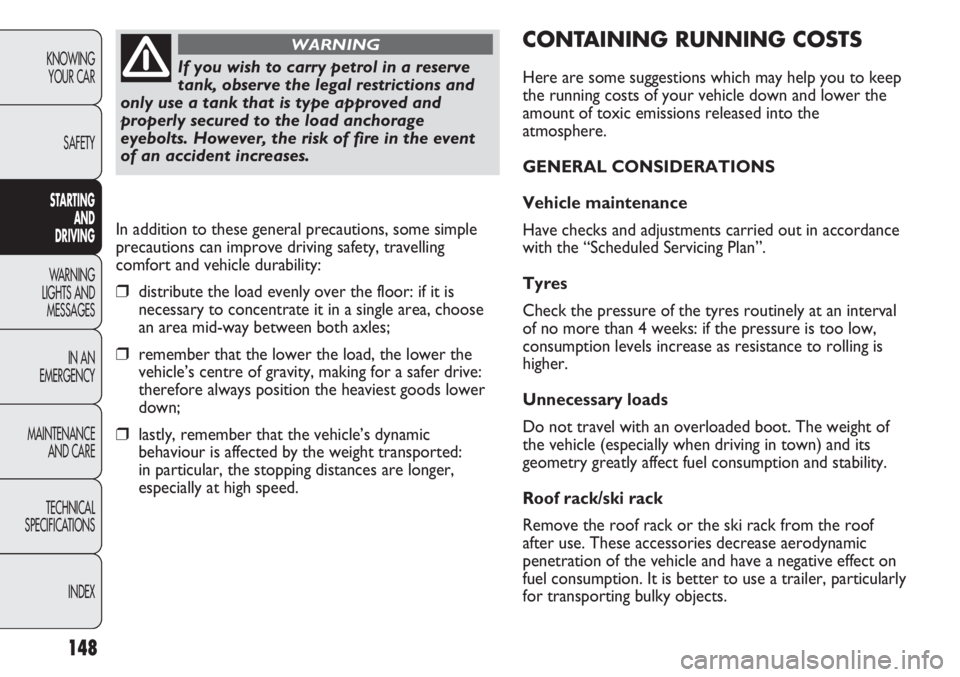
148
KNOWING
YOUR CAR
SAFETY
STARTING
AND
DRIVING
WARNING
LIGHTS AND
MESSAGES
IN AN
EMERGENCY
MAINTENANCE
AND CARE
TECHNICAL
SPECIFICATIONS
INDEX
CONTAINING RUNNING COSTS
Here are some suggestions which may help you to keep
the running costs of your vehicle down and lower the
amount of toxic emissions released into the
atmosphere.
GENERAL CONSIDERATIONS
Vehicle maintenance
Have checks and adjustments carried out in accordance
with the “Scheduled Servicing Plan”.
Tyres
Check the pressure of the tyres routinely at an interval
of no more than 4 weeks: if the pressure is too low,
consumption levels increase as resistance to rolling is
higher.
Unnecessary loads
Do not travel with an overloaded boot. The weight of
the vehicle (especially when driving in town) and its
geometry greatly affect fuel consumption and stability.
Roof rack/ski rack
Remove the roof rack or the ski rack from the roof
after use. These accessories decrease aerodynamic
penetration of the vehicle and have a negative effect on
fuel consumption. It is better to use a trailer, particularly
for transporting bulky objects. In addition to these general precautions, some simple
precautions can improve driving safety, travelling
comfort and vehicle durability:
❒distribute the load evenly over the floor: if it is
necessary to concentrate it in a single area, choose
an area mid-way between both axles;
❒remember that the lower the load, the lower the
vehicle’s centre of gravity, making for a safer drive:
therefore always position the heaviest goods lower
down;
❒lastly, remember that the vehicle’s dynamic
behaviour is affected by the weight transported:
in particular, the stopping distances are longer,
especially at high speed.
If you wish to carry petrol in a reserve
tank, observe the legal restrictions and
only use a tank that is type approved and
properly secured to the load anchorage
eyebolts. However, the risk of fire in the event
of an accident increases.
WARNING
Page 153 of 287
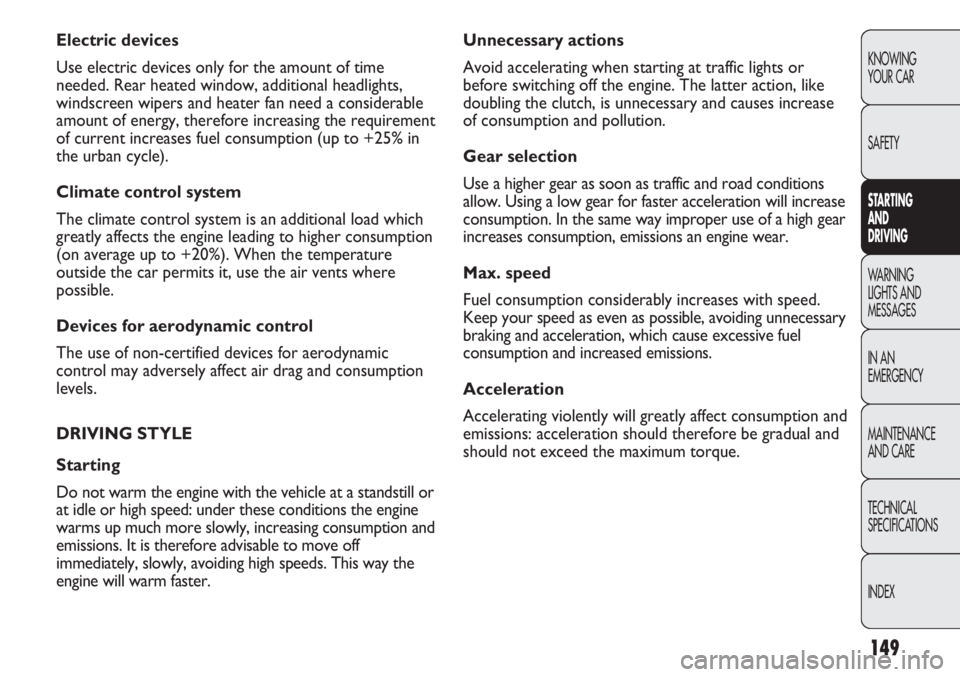
149
KNOWING
YOUR CAR
SAFETY
STARTING
AND
DRIVING
WARNING
LIGHTS AND
MESSAGES
IN AN
EMERGENCY
MAINTENANCE
AND CARE
TECHNICAL
SPECIFICATIONS
INDEX
Unnecessary actions
Avoid accelerating when starting at traffic lights or
before switching off the engine. The latter action, like
doubling the clutch, is unnecessary and causes increase
of consumption and pollution.
Gear selection
Use a higher gear as soon as traffic and road conditions
allow. Using a low gear for faster acceleration will increase
consumption. In the same way improper use of a high gear
increases consumption, emissions an engine wear.
Max. speed
Fuel consumption considerably increases with speed.
Keep your speed as even as possible, avoiding unnecessary
braking and acceleration, which cause excessive fuel
consumption and increased emissions.
Acceleration
Accelerating violently will greatly affect consumption and
emissions: acceleration should therefore be gradual and
should not exceed the maximum torque. Electric devices
Use electric devices only for the amount of time
needed. Rear heated window, additional headlights,
windscreen wipers and heater fan need a considerable
amount of energy, therefore increasing the requirement
of current increases fuel consumption (up to +25% in
the urban cycle).
Climate control system
The climate control system is an additional load which
greatly affects the engine leading to higher consumption
(on average up to +20%). When the temperature
outside the car permits it, use the air vents where
possible.
Devices for aerodynamic control
The use of non-certified devices for aerodynamic
control may adversely affect air drag and consumption
levels.
DRIVING STYLE
Starting
Do not warm the engine with the vehicle at a standstill or
at idle or high speed: under these conditions the engine
warms up much more slowly, increasing consumption and
emissions. It is therefore advisable to move off
immediately, slowly, avoiding high speeds. This way the
engine will warm faster.
Page 220 of 287
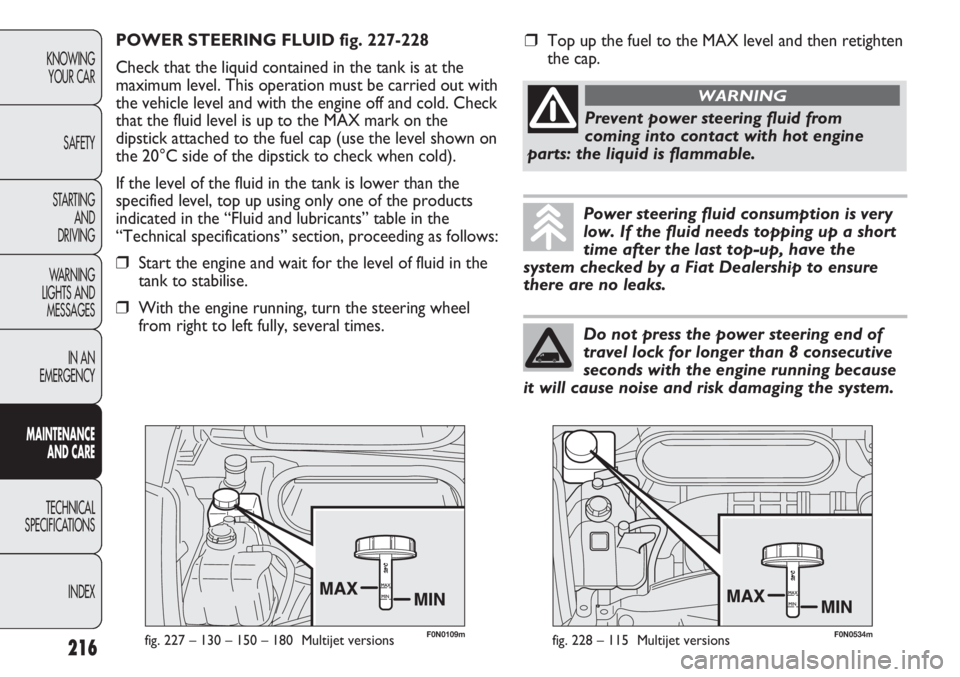
F0N0109mfig. 227 – 130 – 150 – 180 Multijet versions
POWER STEERING FLUID fig. 227-228
Check that the liquid contained in the tank is at the
maximum level. This operation must be carried out with
the vehicle level and with the engine off and cold. Check
that the fluid level is up to the MAX mark on the
dipstick attached to the fuel cap (use the level shown on
the 20°C side of the dipstick to check when cold).
If the level of the fluid in the tank is lower than the
specified level, top up using only one of the products
indicated in the “Fluid and lubricants” table in the
“Technical specifications” section, proceeding as follows:
❒Start the engine and wait for the level of fluid in the
tank to stabilise.
❒With the engine running, turn the steering wheel
from right to left fully, several times.
216
KNOWING
YOUR CAR
SAFETY
STARTING
AND
DRIVING
WARNING
LIGHTS AND
MESSAGES
IN AN
EMERGENCY
MAINTENANCE
AND CARE
TECHNICAL
SPECIFICATIONS
INDEX
Power steering fluid consumption is very
low. If the fluid needs topping up a short
time after the last top-up, have the
system checked by a Fiat Dealership to ensure
there are no leaks.
Do not press the power steering end of
travel lock for longer than 8 consecutive
seconds with the engine running because
it will cause noise and risk damaging the system.
❒Top up the fuel to the MAX level and then retighten
the cap.
Prevent power steering fluid from
coming into contact with hot engine
parts: the liquid is flammable.
WARNING
F0N0534mfig. 228 – 115 Multijet versions
Page 270 of 287
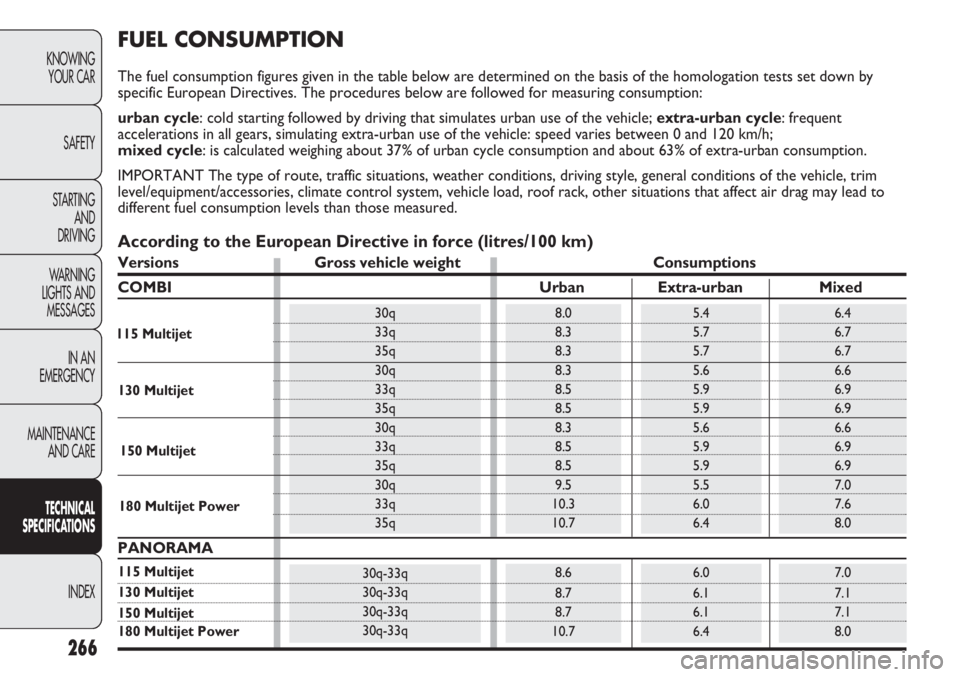
266
KNOWING
YOUR CAR
SAFETY
STARTING
AND
DRIVING
WARNING
LIGHTS AND
MESSAGES
IN AN
EMERGENCY
MAINTENANCE
AND CARE
TECHNICAL
SPECIFICATIONS
INDEX
FUEL CONSUMPTION
The fuel consumption figures given in the table below are determined on the basis of the homologation tests set down by
specific European Directives. The procedures below are followed for measuring consumption:
urban cycle: cold starting followed by driving that simulates urban use of the vehicle; extra-urban cycle: frequent
accelerations in all gears, simulating extra-urban use of the vehicle: speed varies between 0 and 120 km/h;
mixed cycle: is calculated weighing about 37% of urban cycle consumption and about 63% of extra-urban consumption.
IMPORTANT The type of route, traffic situations, weather conditions, driving style, general conditions of the vehicle, trim
level/equipment/accessories, climate control system, vehicle load, roof rack, other situations that affect air drag may lead to
different fuel consumption levels than those measured.
6.0
6.1
6.1
6.4
5.4
5.7
5.7
5.6
5.9
5.9
5.6
5.9
5.9
5.5
6.0
6.46.4
6.7
6.7
6.6
6.9
6.9
6.6
6.9
6.9
7.0
7.6
8.0
7.0
7.1
7.1
8.08.6
8.7
8.7
10.7
8.0
8.3
8.3
8.3
8.5
8.5
8.3
8.5
8.5
9.5
10.3
10.7
30q-33q
30q-33q
30q-33q
30q-33q
30q
33q
35q
30q
33q
35q
30q
33q
35q
30q
33q
35q 150 Multijet 130 Multijet
180 Multijet Power 115 Multijet
According to the European Directive in force (litres/100 km)
Versions Gross vehicle weight Consumptions
COMBI Urban Extra-urban Mixed
PANORAMA
115 Multijet
130 Multijet
150 Multijet
180 Multijet Power
Page 278 of 287
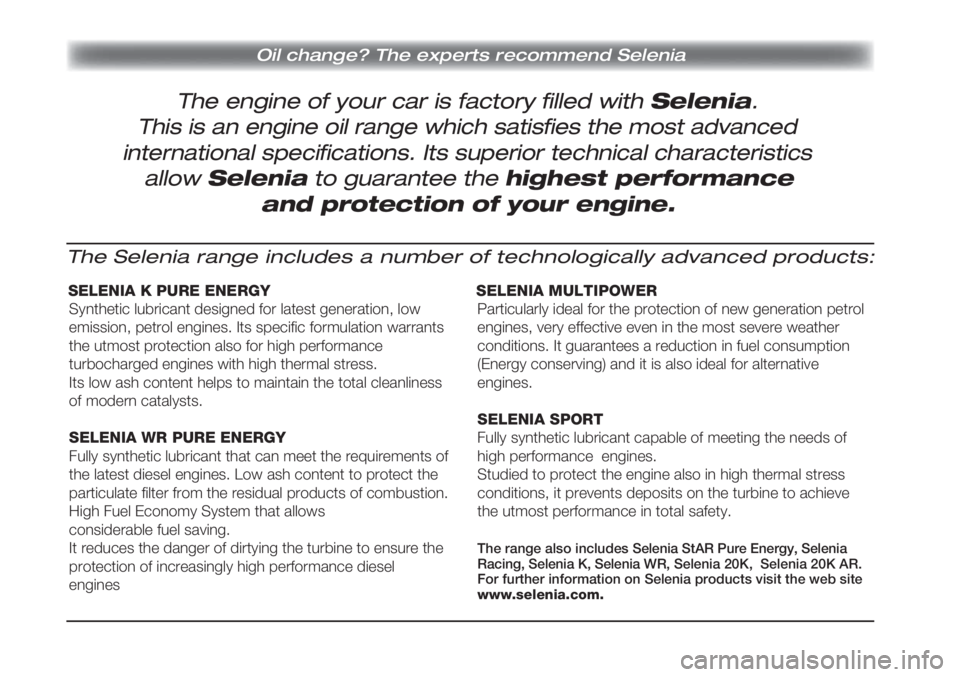
The engine of your car is factory filled with Selenia.
Oil change? The experts recommend Selenia
This is an engine oil range which satisfies the most advanced
international specifications. Its superior technical characteristics
allowSelenia to guarantee the highest performance
and protection of your engine.
The Selenia range includes a number of technologically advanced products:
SELENIA K PURE ENERGY
Synthetic lubricant designed for latest generation, low
emission, petrol engines. Its specific formulation warrants
the utmost protection also for high performance
turbocharged engines with high thermal stress.
Its low ash content helps to maintain the total cleanliness
of modern catalysts.
SELENIA WR PURE ENERGY
Fully synthetic lubricant that can meet the requirements of
the latest diesel engines. Low ash content to protect the
particulate filter from the residual products of combustion.
High Fuel Economy System that allows
considerable fuel saving.
It reduces the danger of dirtying the turbine to ensure the
protection of increasingly high performance diesel
enginesSELENIA MULTIPOWER
Particularly ideal for the protection of new generation petrol
engines, very effective even in the most severe weather
conditions. It guarantees a reduction in fuel consumption
(Energy conserving) and it is also ideal for alternative
engines.
SELENIA SPORT
Fully synthetic lubricant capable of meeting the needs of
high performance engines.
Studied to protect the engine also in high thermal stress
conditions, it prevents deposits on the turbine to achieve
the utmost performance in total safety.
The range also includes Selenia StAR Pure Energy, Selenia
Racing, Selenia K, Selenia WR, Selenia 20K, Selenia 20K AR.
For further information on Selenia products visit the web site
www.selenia.com.
Page 281 of 287
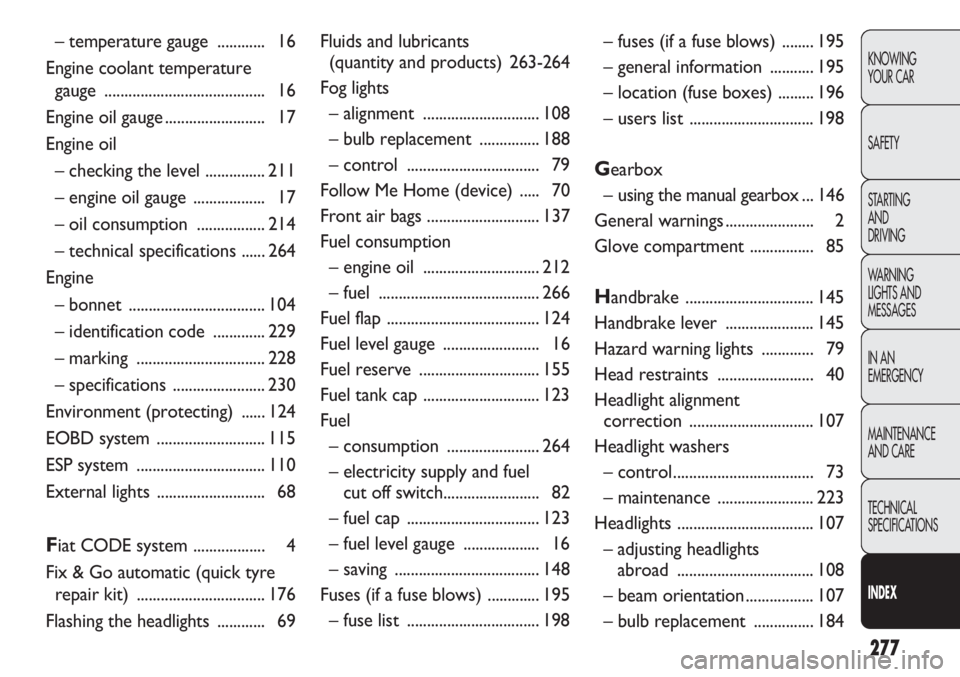
277
KNOWING
YOUR CAR
SAFETY
STARTING
AND
DRIVING
WARNING
LIGHTS AND
MESSAGES
IN AN
EMERGENCY
MAINTENANCE
AND CARE
TECHNICAL
SPECIFICATIONS
INDEX
Fluids and lubricants
(quantity and products) 263-264
Fog lights
– alignment ............................. 108
– bulb replacement ............... 188
– control ................................. 79
Follow Me Home (device) ..... 70
Front air bags ............................ 137
Fuel consumption
– engine oil ............................. 212
– fuel ........................................ 266
Fuel flap ...................................... 124
Fuel level gauge ........................ 16
Fuel reserve .............................. 155
Fuel tank cap ............................. 123
Fuel
– consumption ....................... 264
– electricity supply and fuel
cut off switch........................ 82
– fuel cap ................................. 123
– fuel level gauge ................... 16
– saving .................................... 148
Fuses (if a fuse blows) .............195
– fuse list ................................. 198– fuses (if a fuse blows) ........ 195
– general information ........... 195
– location (fuse boxes) ......... 196
– users list ............................... 198
Gearbox
– using the manual gearbox ... 146
General warnings...................... 2
Glove compartment ................ 85
Handbrake ................................ 145
Handbrake lever ...................... 145
Hazard warning lights ............. 79
Head restraints ........................ 40
Headlight alignment
correction ............................... 107
Headlight washers
– control................................... 73
– maintenance ........................ 223
Headlights .................................. 107
– adjusting headlights
abroad .................................. 108
– beam orientation................. 107
– bulb replacement ............... 184 – temperature gauge ............ 16
Engine coolant temperature
gauge ........................................ 16
Engine oil gauge ......................... 17
Engine oil
– checking the level ............... 211
– engine oil gauge .................. 17
– oil consumption ................. 214
– technical specifications ...... 264
Engine
– bonnet .................................. 104
– identification code ............. 229
– marking ................................ 228
– specifications ....................... 230
Environment (protecting) ...... 124
EOBD system ........................... 115
ESP system ................................ 110
External lights ........................... 68
Fiat CODE system .................. 4
Fix & Go automatic (quick tyre
repair kit) ................................ 176
Flashing the headlights ............ 69